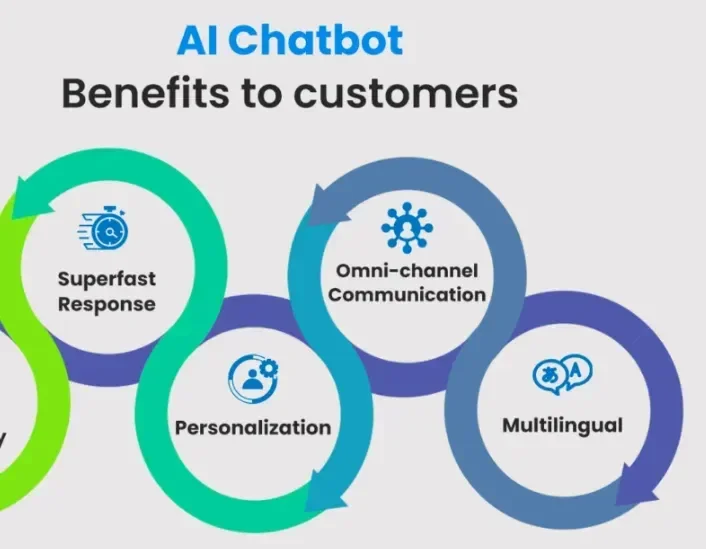Businesses are increasingly relying on sophisticated chatbots to handle customer inquiries, offering instant support and streamlined interactions.
These virtual assistants, known as customer service chatbots, are revolutionizing how companies engage with their clientele, providing a 24/7 accessible support system.
From simple product inquiries to complex technical issues, these intelligent bots can efficiently address a wide array of customer service requests, freeing up human agents to handle more intricate problems.
Understanding how chatbots in customer service operate is crucial for anyone involved in business, from frontline staff to senior management.
The efficiency and cost-effectiveness of these automated systems are transforming customer experiences, impacting customer satisfaction and brand loyalty.
A key benefit lies in the speed and availability of chatbot support. Customers can receive immediate responses, resolving issues quickly and minimizing frustration.
Furthermore, intelligent chatbots can handle a large volume of queries simultaneously, reducing the workload on human agents and enabling them to focus on more complex or personalized support.
This article dives deep into the expanding role of chatbots in customer service, exploring their capabilities, limitations, and future prospects. The potential of these virtual agents in improving customer journeys is considerable, highlighting why this topic holds substantial relevance for organizations navigating the digital landscape.
By examining the different types of chatbots, the crucial design considerations, and the impact on customer support workflows, we aim to provide a comprehensive understanding of how chatbots are changing customer service interactions.
The Evolution of Customer Service Chatbots
Customer service chatbots are rapidly evolving from basic question-answering systems to sophisticated conversational agents capable of handling increasingly complex customer interactions.
This evolution is driven by advancements in natural language processing (NLP) and machine learning (ML), enabling chatbots to better understand and respond to human language.
The core functionality of modern chatbots in customer service hinges on their ability to interpret user input, identify the customer’s needs, and provide relevant solutions.
Consequently, the user experience is significantly improved by the adaptability of these virtual assistants.
This increased sophistication is crucial for handling multifaceted customer inquiries, from order tracking and troubleshooting to answering frequently asked questions (FAQs) and guiding customers through self-service options.
Early chatbots often struggled with nuanced language and context, leading to frustrating or unhelpful interactions. However, current models leverage sophisticated algorithms to address these shortcomings.
As a result, chatbots are becoming more proficient at understanding complex user queries and providing accurate and helpful responses.
This progress is not without its challenges. Ensuring the chatbot’s accuracy and appropriateness for diverse customer interactions remains a crucial area of development.
Training data quality and the ongoing refinement of NLP models are integral to this process.
A critical component of this evolution involves the integration of chatbots with existing customer relationship management (CRM) systems, enabling seamless data access and personalized interactions.
This integration allows chatbots to access a wealth of customer information, enabling them to provide more tailored support and anticipate customer needs.
The seamless integration of these technologies fosters a more holistic approach to customer service, improving efficiency and overall satisfaction.
By leveraging this technological advancement, businesses can optimize their support infrastructure, providing superior and responsive service.
The future of customer service chatbots promises further refinement and integration with other technologies, potentially leading to even more intuitive and human-like interactions with customers.
The Impact of Chatbots on Customer Interactions
The integration of chatbots into customer service significantly alters the dynamics of client interaction, fostering more efficient and personalized support experiences.
These sophisticated virtual assistants provide immediate assistance across diverse customer service requests, from basic inquiries to complex technical issues, regardless of time zone or business hours.
This 24/7 availability optimizes customer satisfaction metrics and enhances brand loyalty by ensuring prompt responses to customer needs.
Customer service chatbots streamline support workflows, enabling companies to address a greater volume of inquiries while maintaining consistently high standards.
The improved efficiency of these automated systems translates to reduced costs and a more proactive approach to customer relations, leading to greater profitability and business expansion opportunities.
By automating routine tasks, chatbots free up human agents to focus on more nuanced and complex problems, fostering a more effective and productive customer support team.
The enhanced customer experience facilitated by these systems also directly influences brand reputation and customer loyalty, bolstering the company’s overall standing in the marketplace.
Furthermore, chatbots can analyze customer interactions to gather valuable insights into customer preferences, product usage, and areas for improvement in company processes.
This data-driven approach facilitates targeted interventions and tailored solutions, empowering companies to optimize their customer service strategy.
Consequently, businesses gain a deeper understanding of their customers through these intelligent systems, allowing for more effective strategies and personalized experiences.
The scalability of chatbot implementation makes these systems highly adaptable to changing business needs and evolving customer demands, accommodating growing volumes of inquiries with ease.
Ultimately, the seamless integration of these sophisticated chatbots leads to an improved customer journey, enhancing satisfaction and fostering long-term brand relationships.
Businesses benefit from a cost-effective and efficient customer service strategy that promotes rapid response times and a consistent customer experience.
This technology empowers companies to proactively address client needs and streamline operations within their customer support systems, ultimately promoting greater business growth.
Scalability and Deployment of Chatbots
Scalability is a critical aspect of chatbot implementation in customer service, directly impacting its effectiveness and overall value to a business.
A chatbot’s ability to handle a growing volume of customer inquiries without degrading performance or response times is paramount for maintaining a positive customer experience.
Without proper scalability, chatbots may struggle to efficiently serve a larger customer base, potentially leading to long waiting times, missed interactions, and a negative impact on customer satisfaction.
The scalability of a chatbot system hinges on several factors, including the underlying infrastructure, the chatbot’s design, and the integration with other business systems.
A robust infrastructure allows for horizontal scaling, enabling the system to handle an increasing load by adding more chatbot instances or servers. This ensures that the chatbot service can seamlessly adapt to fluctuations in customer demand, handling a high volume of interactions without compromising speed or functionality.
A well-designed chatbot architecture is crucial for achieving scalability. This includes modular design principles, allowing for independent scaling of individual components and a clear separation of concerns.
Efficient deployment strategies are also essential for maintaining performance and ensuring seamless integration with existing customer service workflows.
A chatbot platform’s deployment should consider factors such as cloud-based solutions, which offer significant scalability and flexibility, allowing resources to be dynamically allocated based on real-time demand.
Properly integrating the chatbot with existing customer relationship management (CRM) systems or other backend systems is vital for providing a seamless customer journey.
The ability to automate tasks like routing requests to appropriate agents and maintaining consistent data across platforms is essential for handling a large volume of inquiries and providing accurate and personalized responses in a timely manner.
Scalable deployment, through various solutions like cloud platforms or microservice architectures, enables businesses to leverage the full potential of their chatbot implementations.
This strategic focus on scalability significantly increases the effectiveness and return on investment (ROI) of chatbot solutions by ensuring that the chatbot can adapt and respond to an increasing customer base efficiently.
By carefully considering the scalability factors during the design and deployment phases, companies can ensure the chatbot continues to be a valuable asset as the business grows, thereby maximizing the positive impact on customer service.
Ultimately, scalable deployment is an integral part of ensuring a chatbot’s long-term success in providing high-quality customer support.
For a chatbot to excel in customer service, achieving scalability is critical in ensuring a consistently positive and efficient customer experience that caters to the changing needs of the business.
Scalability and Deployment of Chatbots in Customer Service
The scalability of a chatbot system is crucial for a business seeking to leverage its potential in customer service.
This aspect focuses on how easily the chatbot can handle increasing volumes of customer interactions as the business grows or experiences peak periods.
A scalable chatbot solution allows a company to manage fluctuating customer demand, ensuring consistent service quality and efficiency, even during surges in customer traffic.
This is essential for maintaining customer satisfaction and avoiding service disruptions that negatively impact the customer experience and brand perception.
Without adequate scalability, a chatbot can become overwhelmed, leading to long wait times, inaccurate responses, and ultimately, a dissatisfied customer base. Consequently, a well-designed and implemented chatbot system must be equipped to accommodate future growth and potential increases in chatbot usage.
Different deployment strategies exist for maximizing a chatbot’s scalability. Cloud-based chatbot platforms often offer the greatest scalability, allowing for easy scaling up or down of resources based on real-time needs.
Another significant element of deployment involves integration with existing customer relationship management (CRM) systems. This ensures seamless data flow between the chatbot and the CRM, providing a holistic view of the customer journey.
Furthermore, effective load balancing techniques are vital for distributing customer interactions across multiple chatbot instances, preventing bottlenecks and ensuring optimal response times.
This crucial aspect of chatbot implementation ensures that the chatbot effectively handles a growing customer base without compromising the quality of its support or response speed, thereby providing a compelling reason for businesses to incorporate chatbots into their customer service strategies.
By focusing on scalability and robust deployment strategies, businesses can ensure their chatbot system continues to be a valuable asset as the business grows, creating a sustainable and effective customer service approach.
In conclusion, the integration of chatbots into customer service has proven to be a transformative force, streamlining operations and improving the overall customer experience.
From handling routine inquiries to providing instant support, chatbots have dramatically reduced response times and significantly improved first-contact resolution rates, leading to increased customer satisfaction and loyalty.
The key benefits of implementing these AI-powered solutions extend beyond efficiency; they liberate human agents to focus on more complex and nuanced customer interactions, thereby maximizing their effectiveness and fostering a more personalized approach to customer service.
The future of customer service is undeniably intertwined with the continued evolution of chatbots. As these technologies continue to advance, incorporating natural language processing and machine learning, their ability to anticipate customer needs and deliver personalized solutions will only increase, further solidifying their importance in modern businesses.
Ultimately, chatbots are not meant to replace human agents, but rather to augment their capabilities. By offloading simple tasks to these automated systems, businesses can create a more efficient, responsive, and engaging customer service experience, paving the way for sustained growth and success in the increasingly competitive marketplace.




